Let’s say you’re very wealthy. Like, super-wealthy.
Whether you paid your way through university while working two jobs and are a self-made individual at 49-years-old, or whether you simply inherited your parents’ wealth, isn’t important.
But let’s say that you spend $10 Million on a house in an extremely upscale area of the city.
Should you have an expectation that the 90 x 200 foot lot next door to your 90 x 200 foot lot isn’t the site of, oh, I dunno, say, the next safe injection site in Toronto?
Forget expectations. What about the right? Should you have the right to demand that after paying $10 Million for your home, the property next door shouldn’t be rebuilt as a homeless shelter?
What if your property was “only” $2.5 Million?
And what if the proposal for the property next door wasn’t a soup kitchen, but simply a 6-plex?
My point is this: when do you become a NIMBY?
There’s a line, right?
I mean, I think an overwhelming majority of us would agree that ‘if’ we paid $10 Million for a house in Forest Hill, we wouldn’t expect that the property next door turns into one of the cliche, less-than-desired examples noted above.
Who among us wants to say that aloud to ourselves, let alone in a group of people? I don’t know. You guys have the cloak of anonymity to post in the comments, so do so freely, if you want.
But I’m wondering where the line is drawn between “realistic expectations” and NIMBY’ism because I think there’s a massive grey area.
There has always been NIMBY’ism in Toronto.
The best and oldest example, which I’m hoping some of the old(er) readers can provide some first-hand-insight about, is the failed “Spadina Expressway.”
For those not familiar, consider Highway 401 for a moment and just how crucial that piece of infrastructure is in our city. Now imagine if it were connected to the downtown core? No, not via the DVP or the 427, but rather directly to the downtown core, through the heart of the city.
That was the plan back in the 1940’s when the planning department tried to get ahead of population growth and account for urban sprawl. Planning continued through the 1940’s and into the 1950’s (seems it was just as slow back then as it is now…), but it wasn’t until December 12th, 1961 that the Metro Council approved the “Spadina Expressway” and planned for construction to take place from 1967 to 1970.
The 401 would connect to the downtown core via an expressway, and the city’s long-term growth plan would be put into action! Great planning starts fifty years in advance!
Opposition began immediately.
Residents of Cedarvale, Forest Hill, Lawrence Heights, York Township, and other areas all opposed the project and fought it from the very start.
Construction began, but it seemed like it was never going to be finished.
Opposition groups at one point actually formed a corporation, called “The Spadina Review Corporation” and hired the country’s best and most infamous lawyer of the day to represent them in their fight against the city.
It took years, but in the end, they successfully fought to kill the Spadina Expressway.
The project died on June 3rd, 1971.
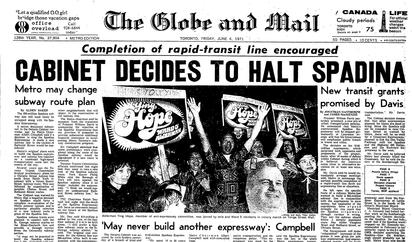
What we have left is known today as Allen Road, which many people dub, “The road to nowhere.”
You could write an entire book about the failed Spadina Expressway and have room left over for a sequel.
The story is either about the power of the people to defeat bad planning, poor government, and leaders who don’t lead in the way that they were elected, or, it’s about NIMBY’sim at its absolute finest.
On February 2nd, 2022, Toronto’s city council gave the green light to garden suites after many years of lobbying by Torontonians.
In a city that is, and has been for a long time, mired in a true “housing crisis,” it seems that almost any idea that would lead to an increase in the number of dwellings in the city is one that should be explored, potentially encouraged, and if it’s warranted, approved.
Upon approving garden suites, the city had this to say:
The introduction of garden suites across the city adds a new form of housing to the range of housing permitted across Toronto’s neighbourhoods, increasing both the variety and type of housing available in these areas for residents. Increasing the number and variety of housing in the city is critical to addressing Toronto’s housing needs, providing more housing options for people at different ages, household structures, and incomes, for people to move within their current neighbourhood to support generational housing turnover, and for new residents to find a home.
While many lots in the city may accommodate a garden suite, not every property is suitable for one. Various factors will influence whether a property can accommodate a garden suite, such as lot width or depth, location and depth of the main house, adequate emergency access, and the location of protected trees. The regulations have been designed so that the size and setbacks of a garden suite are relative to the scale of the property and the size and location of the main house.
The Garden Suites project is one of several initiatives led by the City through its Expanding Housing Options in Neighbourhoods (EHON) initiative. The EHON initiative is working to facilitate more low-rise housing in residential neighbourhoods to meet the needs of our growing city. The City continues to expand housing forms in Toronto, ranging from laneway and garden suites to duplexes, triplexes, and low-rise walk-up apartments. The initiative is one solution among a range of City initiatives necessary to increase housing choice and access, and create a more equitable, sustainable city.
This was a win for Toronto, right?
This was a win for the housing market?
Sure, in theory.
But it didn’t take very long for some Torontonians to oppose the idea and challenge it in court.
“Homeowners Seeking Appeal Of Toronto’s Decision To Allow Garden Suites”
City News
March 16th, 2022
From the article:
The Building Better Neighbourhoods alliance, which includes resident associations from across Toronto, claims city council “clearly over-reached provincial regulations that limit garden suites to single-detached, semi-detached, and townhouses.”
They add there is no legal authority to allow garden suites in zoning for multiplexes and low-rise apartments without developing appropriate standards.
They also argue that while they support garden suites, the bylaw should be “tailored to the different circumstances of neighbourhoods and implemented with appropriate policies and standards.”
Is this NIMBY’ism?
Or is this a fair challenge?
A spokesperson for the group said: “We aren’t against affordable housing, but we do feel that the overreach that has been exhibited by approval of this policy is not in the best interest of any of those mandates that the city or the province has done.”
Sure, why not?
The irony is, the cost of the appeal is merely around $400, so with the way the current rules exist, an individual could potentially tie up the Garden Suites project for years by only outlaying a few hundred bucks. That was one of the items noted in the provincial government’s “Task Force Report” back in February.
The City of Toronto has put forth a motion to dismiss this appeal, and that decision will be made on June 2nd, 2022 at the Ontario Land Tribunal.
If the appeal is dismissed, that likely won’t be the end of it. I do believe that the Garden Suites project will move forward, but it’s the opposition that is noteworthy as we discuss “NIMBY’ism” in Toronto.
Last week, I wrote about the last two phases of the revitalization in Regent Park, and blog reader Keith had this to say:
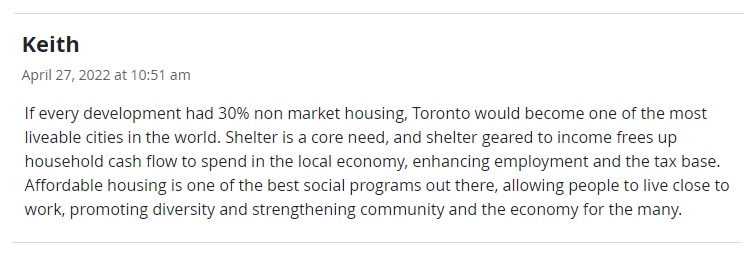
Keith could be completely right on this. Or, completely wrong.
How do you define “liveable?”
I think Keith is right in that if every single condo built in the GTA included 30% non-market housing, we could potentially solve Toronto’s housing crisis, or at least make the largest dent thus far. But would that mean “market price” properties cost more as a result, to make up for the developers’ lost profits? Maybe. Then perhaps we’re back to the same problem.
Another might argue, “Do we want people who can pay $1,000,000 for a condo to live next door to people that rent for $400/month?”
That’s where the conversation can get extremely sensitive.
What’s “liveable” to one isn’t liveable to another. I think we all know that there are people in society who would thumb their nose at living across the hall from people who would otherwise be living in poverty. But as Keith points out, this is the way to solve the housing crisis.
So would opponents of this idea by NIMBY’s? Would they be jerks or would they be wholely justified?
Look south of the border where these “Cancel Student Debt” protests are gaining enough traction that Joe Biden has tabled the idea of foriving up to $10,000 in debt. Opponents of this idea are saying things like, “They never canceled my debt” to “What does this teach future generations about responsibilities?”
Is there a parallel here to the idea of including low-income housing units on the same floor as market-price units? Or are we simply taking care of the most unfortunte members of our society?
I’m often reminded of that famous quote, “A civilization is measured by how it treats its weakest members,” which is actually one of the most famous misquotations of all-time, but I digress. When it comes to including the have-nots with the haves, doesn’t this logic apply?
Now, if we really want to explore NIMBY’ism at its finest in Toronto on a current level, think back to the March blog post, “Just How Dense Should our ‘Densification’ Be?”
This was a blog post about the proposed development at Bayview Avenue & Broadway Avenue which would see five residential, 2-storey dwellings torn down and be replaced by a 25-storey condo.
Here’s the site:
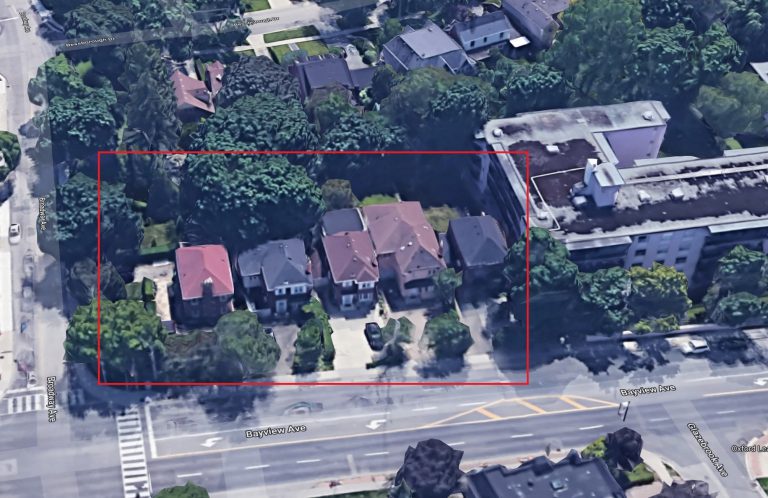
–
In response to the blog post, there were a good number of comments.
Let’s look at two comments that take opposing views.
Here’s one that’s cleary in favour of the project and believes those in opposed to be entitled NIMBY’s:
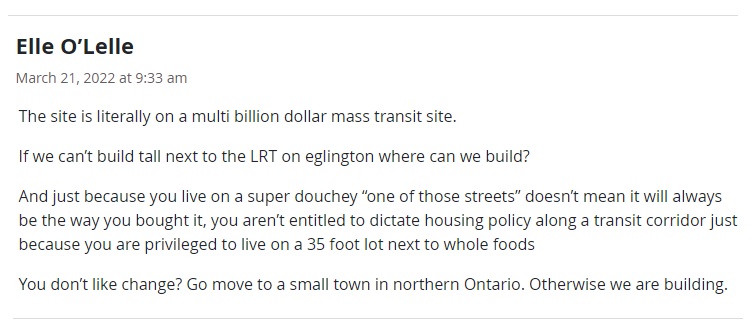
Here’s one that doesn’t directly oppose the development but rather notes the larger issues to be discussed:
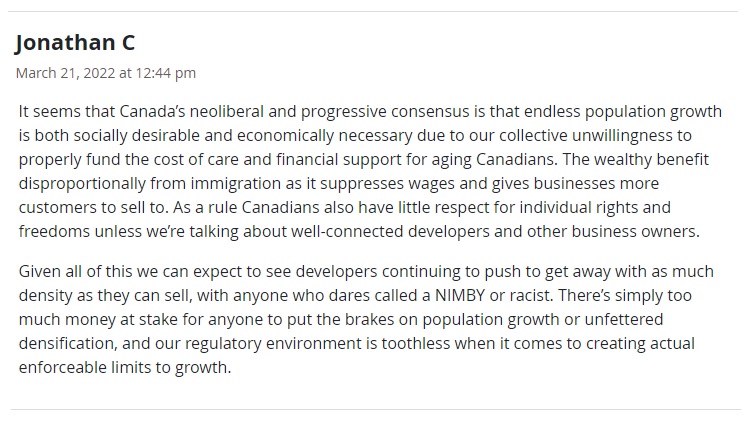
As you might expect, the owners on Bessborough Drive are not pleased with the proposed development at 1837 – 1845 Bayview Avenue.
In fact, every single house on that block has a bright yellow sign that reads, “SAY NO TO BAD PLANNING.”
I was shocked at how quickly this story was acted upon in the media.
I never expected to find myself on TVO.org, but here I was, reading this:
“Keeping New Families Out Of A Nice Neighbourhood? That’s Bad Planning.”
TVO Today
April 21st, 2022
I don’t know the author, and I suspect from the way he wrote the article that he doesn’t live in Leaside proper.
But that doesn’t mean he can’t offer an opinion, and it doesn’t undermine his view, in comparison to the owners on Bessborough Drive, that this proposal is actually “good planning.”
From the article:
It’s the slogan that jumped out at me. “Bad planning.” Bad planning is exactly what brought us here.
The Leaside neighbourhood where I live is exactly where the city should be increasing density. It, like all midtown neighbourhoods, has good access to downtown and excellent access to local commerce and amenities. It’s also precisely where the soon-to-be-completed Eglinton Crosstown will suddenly provide much more mass transit than has traditionally been available. The entire Eglinton corridor is ripe for an influx of new residents, and good planning would account for that and set in place conditions that would permit those new residents to move in — by the many tens of thousands.
That would be saying yes to good planning, right? Mid-rise condo towers along every suitable avenue, with floor space set aside for community amenities where needed? Missing-middle housing approvals for low-rise apartments and multiplexes where only detached single-family homes are now? Gradual improvements to local infrastructure — including parks, schools, and community centres — to better serve a more populated local community?
While I recognize that I grew up in Leaside, have roots in the community, know people in and around the area where the yellow signs are displayed, and could come to have this blog post thrown in my face down the line when myself or my team looks for a foothold in the real estate community, I can’t help but suggest that the opposition to the project has less to do with “bad planning” and more to do with the fact that a giant condo is being built in these peoples’ backyards.
If the objection is that there are too many 1-bedroom condos being built and that the project should have a diverse range of sizes, layouts, and prices, to attract a good number of individuals, groups, and families, then I agree with opposing “bad planning.”
But if the objection is, “I don’t want this built in my backyard,” then I don’t agree.
Maybe not 25-storeys, or maybe not the shape or size of the artist’s rendering. But should we be looking for density near subway stops? Absolutely. That’s good planning.
So at the risk of name-calling, are these folks NIMBY’s?
What would you do if you owned a home in this location?
Would you be a NIMBY or a YIMBY?
Garden suites is but one example. The Broadway/Bayview tower is also but one example.
However, if you put them together, you have two. Add another, and, well, you can do the math.
How many are necessary to label Toronto a “city of NIMBY’s” and where does it end?
Where?
More like if…





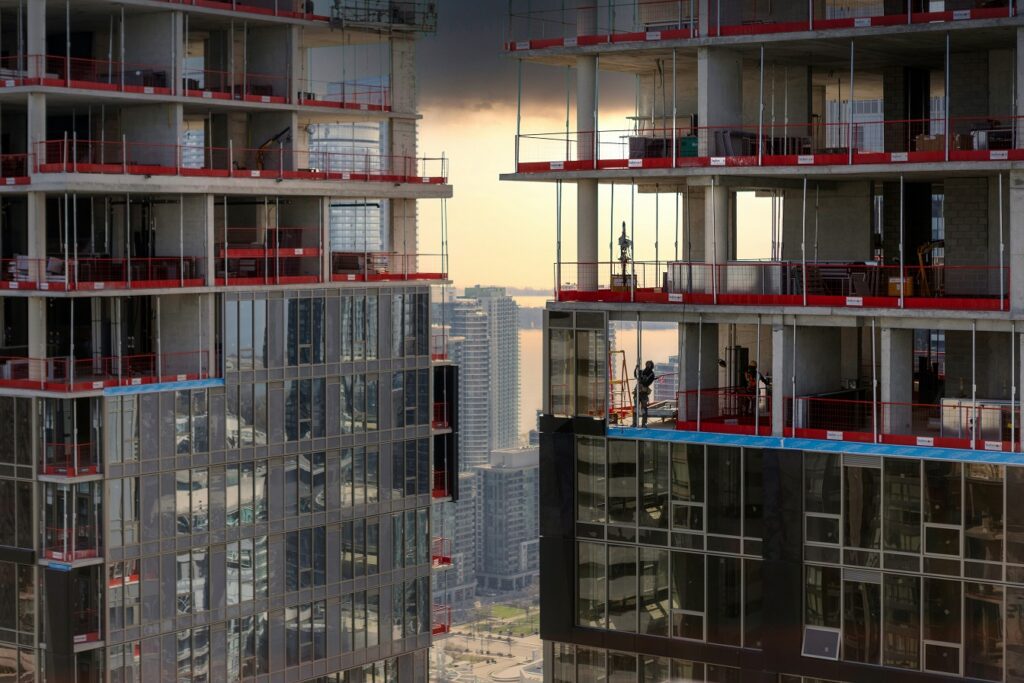
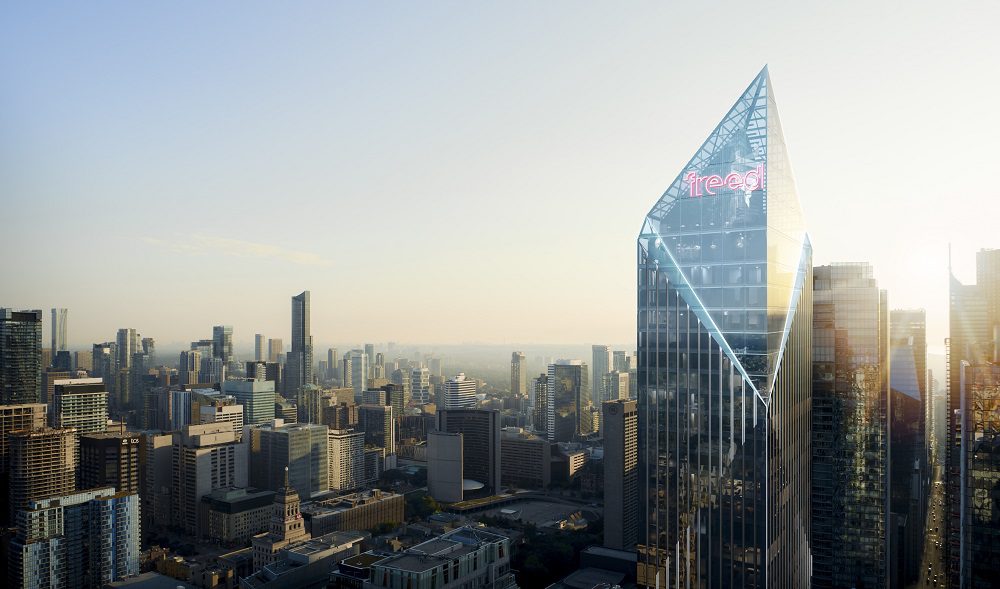

























Marc
at 7:01 am
I do not believe that existing homeowners hold any rights to some expectation of continuity in their neighbourhood. We need to build and the changes will be painful for some of us with an expectation of permanent status quo. One of the problems as I see it is that we’ve gotten to the point where there is no nuance allowed in this debate and I think that is an index of how bad the affordable housing problem has become. We live in a SFH that shares a lane with an avenue and have an 8 storey condo proposed to be built right behind our house. Our position on it has always been – yes, of course, build it, but we’d like to work with the developer to address some concerns from neighbours. But, all of those concerns have been labelled NIMBY and dismissed, forcing a more adversarial stance from neighbours who, ironically are not opposed in theory to the condo in any way. You can say that neighbour’s objections unduly delay and add costs to getting new buildings done, but, at least in this case, the concerns would have been relatively easily addressed if the developer, the city and the neighbourhood had worked together from the beginning. My point is, we have gotten to the point where NIMBY is being weaponized both by existing residents and by developers and housing activists in ways that I think are unproductive in the long term.
Francesca
at 7:11 am
My husband’s aunt and uncle are planning to build a garden suite in their lot at Yonge and Finch for them to move into and give their small 1950s house to their son and his wife and child to live in. They have all the plans in place and are ready to go but are now stalled by this appeal which I believe was put in motion immediately after the city announced the approval. I agree that not all areas of Toronto are suited for this but I feel like this is NIMBY at its finest with people not wanting additional density next door potentially.
As for the idea of having people of multi income living in one condo I do believe this has already happened in Vancouver in some less desirable, gentrifying neighborhoods like Regent Park. Not sure how successful this has been. I could see how people would be reluctant to buy these condos for fear of increased crime potentially and for fear that their property may not appreciate as quickly due to the stigma attached to it. Will be interesting to see if this type of building gets built here in Toronto.
Keith
at 7:24 pm
There are people living in some of the most exclusive neighbourhoods in Vancouver, paying rent at the welfare shelter rate. The conversion of brownfield (former industrial) sites has been happening in Vancouver since the 1980’s. One of the nicest is Coal Harbour, which is a waterfront community next to Stanley Park.
When they planned the site, part of the requirement was to have 20 percent non market housing. Of particular concern was some older gentlemen who lived on their boats in the harbour. They were given first priority to be properly housed ashore, and were given rental accommodation according to their means.
There is non market housing all over the waterfront in Vancouver, Coal Harbour and False Creek north and south. False creek south, done in the idealistic seventies has thirty percent market housing, thirty percent non market, and thirty percent low income non market – a stones throw from Granville island.
If you plan neighbourhoods properly from the start, with liveabililty at the core, instead of negotiating spot rezonings pursuant to a cosy relationship with developers, it’s amazing what you can accomplish.
Alexander
at 9:16 am
The city government should make a very transparent notification system to inform all owners and potential buyers in the affected area when the planning body is upping the density ( and to which level ) at least 5 to 10 years in advance, not when the developer already bought properties and ready to build and trying to squeeze extra 10-15 stores on the top of existing guidelines/regulations. This information should also be automatically included before you are buying a property in the area. And the government should not be allowed to approve the development until this time frame is over and strictly sticking to the density that has been approved 10 years ago. Owners would know the change is coming and buyers are aware that the new monster high-rise will not appear in front of the house in 2 years time. Uncertainty and sadden loss of property appreciation is driving owners mad. It is not related to only SFH, I made the decision not to buy a condo on the 22nd floor because a thru investigation showed there is 34 store building in plans just in front my condo of interest with a south view. The view will be gone in 4-5 years, so why pay a premium for it?
Alexander
at 9:26 am
And I think it is BAD PLANNING if owners do not know what is going to happen to the area where they live at least 5-10 years in advance. And they are not under the current system when developers are applying for higher density all the time. Taking control of immigration flows is certainly another thing that should be calibrated as well.
A Grant
at 9:40 am
From an urban development standpoint, the rejection of the Spadina Expressway was a victory. It was designed to accommodate the mass exodus to the suburbs (and all of the related problems that we are now only just coming to grips with), at a time when those living in urban centres were deemed expendable.
Had this expressway been built, long-established neighbourhoods would have been lost, including large swaths of Forest Hill, the Annex, Kensington Market, Chinatown, etc. Houses that were once a short walk to the shops would have ended up overlooking a six-lane highway. Homes and businesses would have been seized and destroyed under eminent domain. Neighborhoods split in two, all for the sake of faster commute times for those who lived outside the city.
Looking to today, you can’t tell me that Toronto would have been better off and more liveable had the expressway been built. So, to answer David’s question, I suppose you could label the cancellation of the Spadina Expressway as “NIMBYism at its finest”, as opposed to say NIMBYism at its worst.
It’s worth remembering what happened to our neighbours to the south. In the US, following the Federal Aid Highway Act of 1956, highways were routed directly and purposefully through certain communities. Led by the likes of Robert Moses, neighbourhoods considered “blighted” were demolished and cut off from the rest of the city, a legacy that continues to define the landscapes of urban spaces in the US to this day. And like Toronto, there was strong push back from those who wanted to save their communities – of course, unlike Toronto, these voices could simply be ignored. Hazard a guess as to why?
And I doubt anyone would hold this up as a victory for the anti-NIMBYism crowd.
Jennifer
at 1:21 pm
lol. ya no. toronto would have 100% been better off with it. all those places would have been fine as the expressway was set to stop north of them. basically this was a move to “protect” rich forest hill at the expense of everyone else and if anyone denies that they are clueless.
A Grant
at 2:35 pm
The Spadina Expressway, had it been fully realized, would have linked the 401 all the way south to the shores of Lake Ontario at the Gardiner. While the highway might have ended up going underground at Bloor, the upheaval would have wrecked all the neighbourhoods I mentioned. And for what?
A shaving a few minutes off the commute to and from downtown Toronto for those who don’t live in the city, at the expense of those who do? Heck, even if you believe the ends justify the means, the expressway itself would have only resulted in short-term gains. Time and time again, induced demand has shown us that any increase in highway capacity is soon overwhelmed by more cars.
In the 20th century, city planning focused on the automobile at the expense of the people living there. Thankfully, that way of thinking has evolved where we now design urban centres for people, and not just for car movement and storage.
But sure, let’s go with clueless.
Dickson L
at 10:45 pm
If after the cancellation of the Spadina expressway they managed something else to replace it (e.g. rapid transit lines to move commuters without new roadways, more housing units downtown to de-necessitate a suburban commute, etc), then I would have agreed that they did real good. But they didn’t, and eventually the movement grew into a BANANA racket.
Everywhere there had been a Jane Jacobs expressway revolt during the 1970s, there had also been no new rapid transit built to-term for the 40-50 years that followed. Every new subway/RT line in Toronto since the 1970s has been cancelled or cut short due to political resistance. It is important to distinguish Jane Jacobs ideology from genuine new urbanism. Seoul is an example of the latter — they ripped down the Cheonggyecheon Expressway, but it came with a new BRT line plus the now famous artificial riverbed, and this whole time they expanded their subways to replace the expressway’s capacity.
Most of the neighbourhoods you listed remain hotbeds of NIMBYism to this day, especially the Annex where the BANANA racket lives on. In the 1970’s they were staging protests against an expressway. In the 2010’s they were staging protests against affordable housing.
https://www.thestar.com/news/city_hall/2017/08/28/margaret-atwood-joins-fellow-annex-residents-to-fight-condo-project.html
Or how about Cabbagetown and their protest against a daycare:
https://www.toronto.com/news/cabbagetown-residents-up-in-arms-over-proposed-daycare/article_563edea0-2b6f-5f58-9033-6d7c6d06a7dc.html?
You can tell from these actions that the movement is not about “building for people” at all. It is about “preserving character” and not building anything, period.
Craig H.
at 9:51 am
My biggest issue with development is less the densification itself, and more the lack of proper infrastructure planning that should accompany it. I lived in a detached home near Yonge and Eglinton and don’t object to the new buildings (we lived in the UWS in NYC prior so I quite enjoy high density neighbourhoods), I object to the lack of proportionate investment into transit and schools etc. Bringing more rapid transit to the area through the Crosstown LRT? Great. Funneling that traffic into a well-overstretched Line 1 to downtown? Stupid. Adding higher density condo units so families can move into the area? Super. Doing so without adding school capacity? Dumb. The lack of foresight and planning between the city and developers is stunning to me.
Joel
at 12:59 pm
I have a much bigger problem with garden suites then I do with a well planned and placed high rise. There is a high rise a couple of hundred meters from my backyard on a busier street.
My problem with garden suites is that they are not allowed to be severed. So many complaints about housing prices and investors and this is going to make it worse.
If you currently have a $2 million detached as a sfh, what is the value with a main unit rental, basement rental and garden suite in the back? Building a $500K pre-fab house in the back and you have greatly increased the value of that property.
If we are collectively OK with renting being the standard in Toronto moving forward, then this policy works, if people aspire to be owners, we are taking that inventory off of the market. If you can add a garden suite and sever the lot, then that policy makes more sense as it decreases the price of both properties.
Marty
at 6:38 am
I’m not so sure about the math here, in your last paragraph.
$2M sfh now, and add $500k prefab. garden suite.
I’ll agree that the $2M home is worth less upon severance, it loses some/much back yard and privacy. But that new 1,000 sq. ft. prefab will not sell for only $500k.
Keith
at 7:14 pm
I’ll gently expand on my comment referenced in the blog post. Studies show that income and wealth inequality gone too far, reduces the lifespan and quality of life for all people in a society, including the wealthiest. The course we are on, left unchecked will eventually reach some kind of tipping point. In Vancouver, we have people living in parks, greatly increased random assaults, increased petty crime and vandalism of all kinds. People that society has marginalized are expressing their anger.
People who earn a living wage, and own property have a very large stake in a stable community and society. They participate in politics, at least by voting. Our economy is marginalizing more and more people, and even the top professionals like lawyers and doctors are starting to be shut out of certain housing options – they used to have all of them.
The debate in Vancouver has simply become toxic. There is a lobby group called Abundant Housing, which calls for repealing most limitations on building. They call for increasing density ANY way possible. No limits on what you can build, no limits on occupancy (goodbye, fire code), and for sure the end of height limits, setbacks, or any concerns about shadows or view corridors. To oppose them in any way makes you a NIMBY who is against affordablility.
In this century, over 95 percent of the single family homes in Vancouver have been upzoned to at least 3 or 4 units minimum. Land prices have skyrocketed in response. A city increasing in population by 7,000 residents per year has had transformational density added in many neighbourhoods, yet affordability is far worse.
In Vancouver, the city owns over 700 pieces of land. Non market housing can be built by simply leveraging what the taxpayer owns over 40 years, with costs paid by the tenants. The land cost is zero, the government borrows the money for construction at the lowest rate in the market, rents based on income cover long term financing and maintenance. The only cost paid by the taxpayer is the opportunity cost of not using the land to its maximum private sector potential. Not necessarily a bad tradeoff, done properly.
marmota
at 10:13 am
How does income inequality reduces lifespan?
Poverty reduces life expectancy, not income inequality. What we care about is the standard of living. If the standard of living increases, life expectancy does as well – despite inequality.
All cities and societies have had marginalized individuals. Our crime rate has been decreasing over the last decades, regardless of income inequality (that has in many cases worsened).
Land cost is not zero. Either there is opportunity cost for the taxpayer, or we dispose of a good that can’t be recovered. It is everyone’s interest that it is best used, and that might be just hoarding. Imagine if the city had disposed of all those 700 pieces of land 50 years ago… that’s exactly what will happen 50 years from now, many will likely lament that we used them inadequately in our present.
Jonathan C
at 3:53 pm
Imagine my surprise to see myself quoted in a TRB post! I’ll have to ensure that future comments are of similar quality.
I don’t think there’s anything wrong with being a NIMBY, it’s a natural response to object to anything that will substantially change the character of a neighborhood. Especially when a home is most people’s biggest financial asset.
This whole conversation is fundamentally a question of individualism vs. collectivism. Does an individual (or community of individuals) have the right to make decisions for themselves, or is it just and fair if a government overrides local views in favour of the “greater good”? Obviously I favour individual rights in this case.
GR Group
at 1:12 am
Insightful and well-articulated perspective on Toronto’s real estate challenges! Your analysis of NIMBYism and urban development is thought-provoking. Keep up the great work.